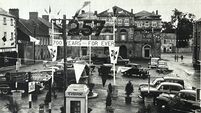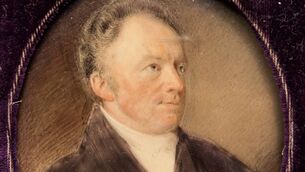Éowyn not the first storm to devastate country

A cypress tree in the Old Cemetery in Athy which was uprooted by Storm Éowyn Photo: Michael O'Rourke
STORM Éowyn has come and gone, leaving behind a devastated countryside. So far as records show Éowyn was the biggest wind storm ever to cross this country and surpassed the generally accepted ‘Night of the Big Wind’ of 6 January 1839.
The winds of 1839 brought a different type of devastation on the Irish people of that time. While there was less destruction of buildings than one might expect following the recent wind storm, the misery experienced as a result of electricity outages and the absence of water supply is shared by many thousands of households.
On the Monday three days after the storm 240,000 houses remained without electricity, while about 109,000 customers were without water supply and a further 126,000 households were classified as ‘at risk’.
The big winds of 1839 destroyed thousands of the poorly constructed dwellings occupied by cottagers and unemployed labourers. Fire was a particular hazard because of the prevalence of thatched roofs.
In Loughrea it was reported that 103 houses were destroyed, of which 71 were burned to the ground. This was a common enough occurrence, particularly along the Western seaboard. Near Athenry in County Galway a house collapsed and went on fire, resulting in the tragic death of the mother of the house and four of her children.
Subsequent reports in the local press gave details of the wind storm destruction across the country. The ‘Galway Weekly Adviser’ claimed that Portarlington suffered more than any other town for its size. That same newspaper reported that large ricks of corn and hay were blown away a mile from the haggards and that rivers and lakes were full of corn and straw.
The ‘Dublin Evening Post’ confirmed this when it reported that many farmers whose haggards were full with unthrashed corn the day before the storm found themselves without a sheaf of grain in the morning.
While the ‘Clonmel Herald’ reported ‘upwards of 300 lives were lost in Ireland by the late hurricane’, it is generally accepted that this was an over estimation.
The actual figures for those who died was nearer 100 and included 12 men of the Roundstone Coast Guard who were drowned during the storm.
I cannot access my archival material at this time but so far as I can remember I never came across any Athy references in relation to the 1839 wind storm. There is no reason to believe Athy escaped the ravages of the storm, but the lack of reporting in the minute books of the Borough Council is surprising. Perhaps, this shouldn’t be surprising when one considers the composition of the council and its obvious lack of interest in the town.
The 1839 windstorm came to the forefront when the English Chancellor Lloyd George introduced the Old Age Pension Act of 1908.
This introduced a non-contributory pension of thirteen pounds a year for eligible persons aged 70 years and older.
Many Irish applicants had no documental evidence of their date of birth as the registration of births, marriages and deaths did not become a statutory requirement until much later.
Catholic Parish Priests were in many cases compiling baptismal records for several years prior to 1839 and if I remember correctly baptismal records in St Michael’s, Athy, were compiled from some time in the middle of the 18th century.
In the absence of such records the Old Age Pension Committees charged with implementing the Pension Act, decided that the claimants’ pension application would be approved if he or she remembered the night of the Big Wind.
Last week’s storm, stronger than any previous storm, caused less structural damage than that of 1839. However, it created huge difficulties for so many households without electricity and without water.
The electricity network team have been working hard since the storm and deserve our gratitude without criticism.
The lady who tackled the Taoiseach some days ago in relation to the alleged failure of the electricity company would no doubt be surprised to read that in 1985 the Jansen Report on the ESB found that the semi-state body was overstaffed to the tune of 3,000 workers.
I am not sure if the water treatment authority, Uisce Eireann, which failed to provide a safe and secure water service following the storm cannot be criticised. Surely every water treatment plant dependent on electricity should have a backup turbine system in place.
The absence of turbines meant that with electricity cut off water could not be supplied. The remedy is straightforward.
It is not only Uisce Eireann who fell down on the job for last week when writing of Athy’s Gaelic Football Club players who captained the Kildare county senior team I omitted to mention Colm Moran and David Hyland.
Colm was captain of the Kildare county senior team in 1988 following Athy’s victory in the 1987 Kildare Championship final. David was captain of the Kildare senior team in 2020 and 2021. Colm and David were therefore the second and third Athy players to captain the senior county team, the previous player being Paul Matthews who captained the Kildare All-Ireland losing team of 1935. As mentioned in last week’s article Paul Matthews and Kevin Feeley, like myself, are not Athy natives, while Colm Moran and David Hyland are. They are therefore the first Athy natives to captain the Kildare senior football team for more than one game.





